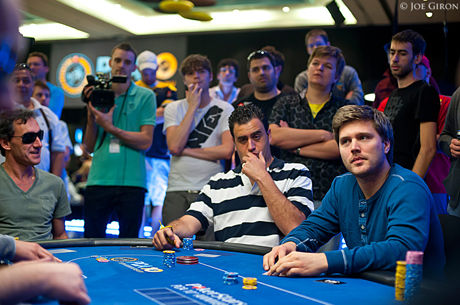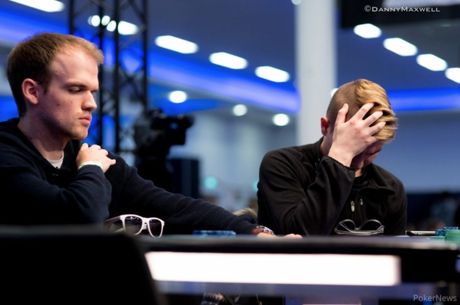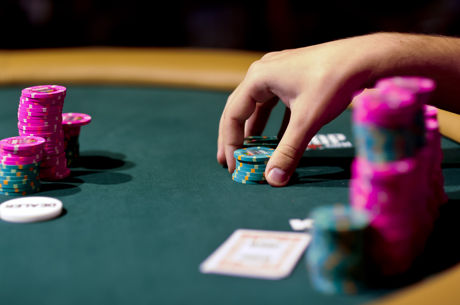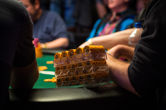What Could My Opponent Have? Solving Range-Reading Problems by Counting

Here is a classic no-limit situation. You call a raise out of the big blind. You then flop a flush draw and eventually make a non-nut flush. But your opponent comes alive on the river, and you have to decide whether to fold, call, or reraise against a big bet.
In these situations you��ll have plenty to think about �� all the bet sizes, which hands your opponent would have checked or bet on which streets, how your opponent perceives you, and so on. Advanced poker requires the careful deduction and combination of these facts. An extra 10 or 20 hand combinations in a betting or checking range on the flop can make a big difference when it comes to figuring out what your opponent can have on the river.
In trying to deal with all the small questions about what a player would do with certain hands on each street, however, players often lose sight of some simple and essential facts about the situation, including forgetting to count the possible flushes their opponents can have.
Your opponent can��t have any flush on the river that he wouldn��t have played as he did on every street. A crude, but sometimes useful, way to model this is as a two-stage process, where the preflop action acts as one filter and the rest of the betting combined acts as another. Here is a lesson in getting the first part of the analysis right. This first factor is much more variable and useful than players often consider.
Let��s say a given opponent would raise in middle position (MP) with suited aces down to Ax8x-suited, suited connectors down to 6x5x, suited one-gappers down to Jx9x, and the other suited Broadway hands. Let��s also say that he would raise in late position (LP) with any suited ace, suited connectors down to 4x3x, suited one-gappers down to 6x4x, and any suited hand with both cards 8x or larger.
Adding this up, the first range includes 18 suited hands in each of the four suits; the second range will have 36, twice as many.
In any given river situation, your hand and the board will block some of those combinations. Here are two tables with the flush cards on board on one axis and the two ranges on the other axis (we��ll use hearts). The values are the number of unblocked flush combinations that beat you and that you beat (in that order). In the first scenario, you have made a flush with Q?J?; in the second, you have 7?6?.
| You have Q?J?... | |||
|---|---|---|---|
| On the board: | K?8?3? | A?9?2? | 4?3?2? |
| MP | 2 (beat you), 3 (you beat) | 1, 3 | 6, 4 |
| LP | 7, 7 | 2, 9 | 11, 8 |
| You have 7?6?... | |||
|---|---|---|---|
| On the board: | K?8?3? | A?9?2? | 4?3?2? |
| MP | 9 (beat you), 0 (you beat) | 6, 0 | 15, 0 |
| LP | 13, 1 | 10, 1 | 22, 0 |
Comparing these two scenarios, a few conclusions jump out at us:
(1) When we hold Q?J?, we block most of the flushes in a tighter opening range, especially when another Broadway card is on the board. QxJx-suited blocks other parts of an opening range also, but in many of these situations, we will disproportionately block flushes. Moreover, Broadway cards are important blockers to flushes that beat us, and we will often have the best of it even against the flush component of an opponent��s range �� if he would play all flushes the same way.
(2) When we hold a small flush, the tighter range will have roughly two-thirds as many flushes as the looser one, and the looser range will often have vastly more non-flush combinations. It can be valuable to recognize these situations, where the extra flushes added to a tight range to make up a looser (but not maniacal) opening range are largely blocked by the cards you can see.
(3) Our flush with QxJx is often near the middle of an opponent��s flush range. Once you consider the possibility that the opponent would not play his weakest flushes the same way as he would play the best ones, this hand will often be an underdog against the relevant part of an opponent��s value range.
More fundamentally, blockers matter a lot. Often you can count the number of possible flushes on one hand; also often, you need both hands and most or all of your toes.
All of this is only a preliminary to the further work of figuring out how many of these flush hands would have played this way on every street and how many non-flush hands would have done the same. For many of us, however, having a rough sense of these blocking effects will prevent the (often costly) mistakes of thinking that far too many or far too few flushes were in our opponents�� opening ranges.
Thinking Tournament Poker by Nate Meyvis is now available both at Amazon and at nitcast.com. Be sure also to check out Nate and Andrew Brokos on the Thinking Poker podcast, and for more from Nate visit his blog at natemeyvis.com.
Want to stay atop all the latest in the poker world? If so, make sure to get PokerNews updates on your social media outlets. Follow us on Twitter and find us on both Facebook and Google+!









